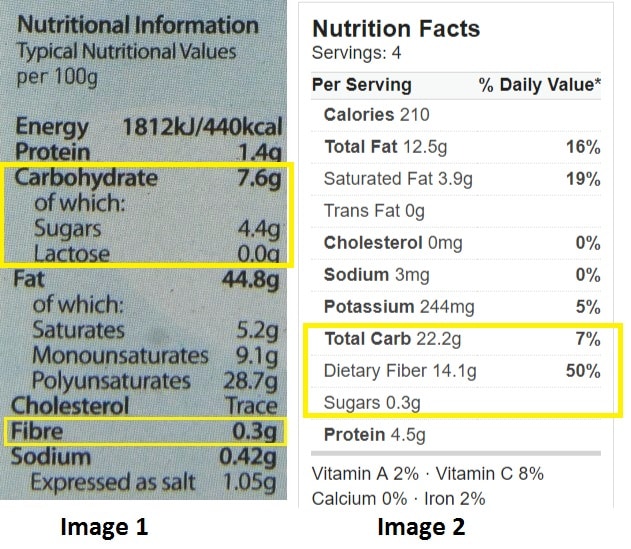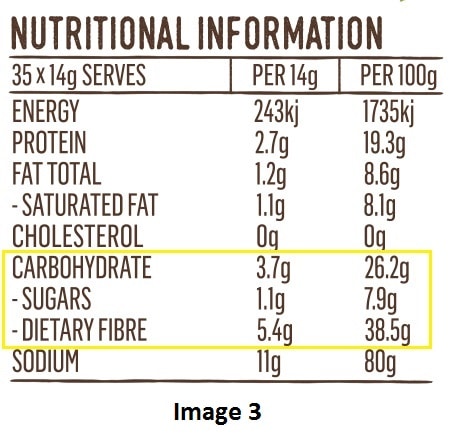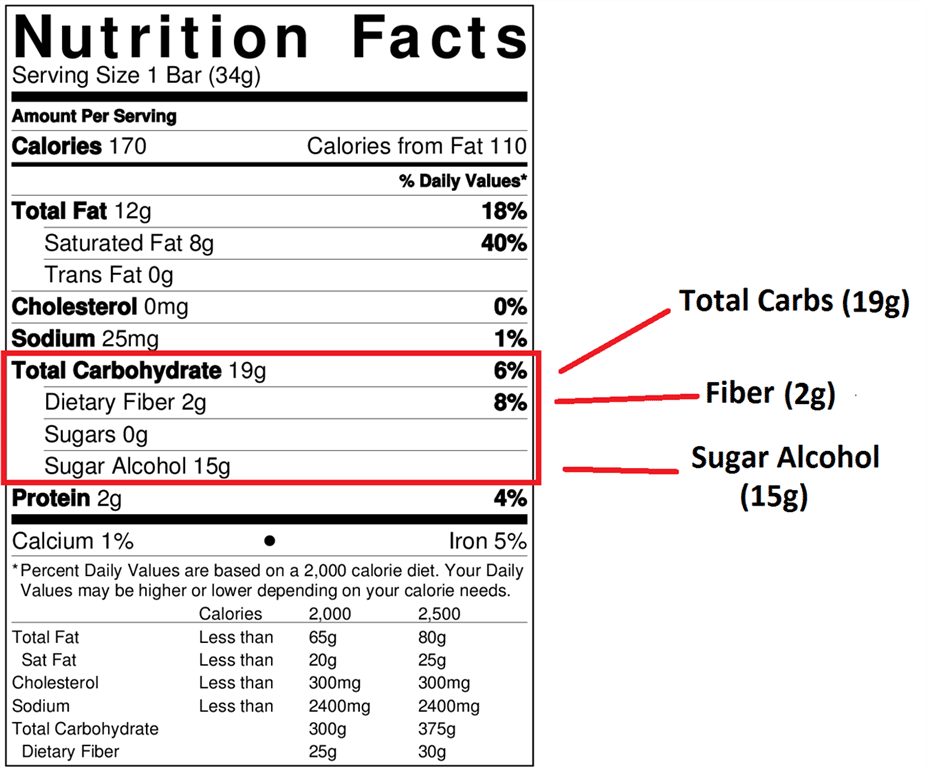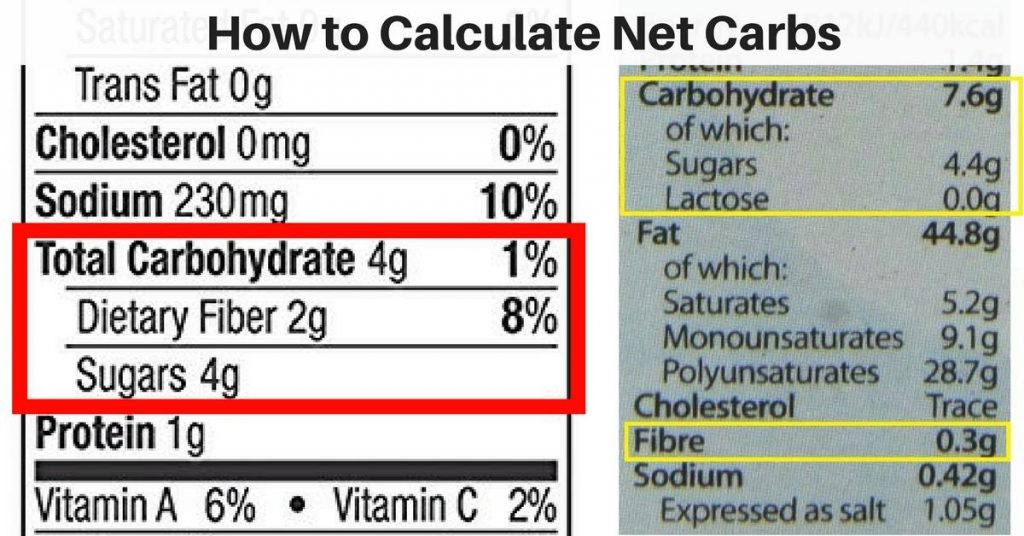The ketogenic diet is characterized by calculating your total daily carbohydrate intake, but did you know that not all carbs are equal? Net carbs are the ones that matter because they impact insulin levels.
Switching off your insulin switch is important because it’s the first step to utilizing fat as fuel instead of carbs.
Figuring out net carbs can be a little bit confusing in the beginning when you first get started with a low carb or ketogenic diet, but gets easier with practice.
This simple and easy-to-understand guide will explain what the difference between total carbs and net carbs is and how you can determine them every time you come across a food nutrition label.
What Are Net Carbs?
Net carbs are the carbohydrates that our bodies can digest and turn into sugar, whereas total carbs include sugar, fiber or indigestible starch.
Fiber does not increase your blood sugar levels. It’s a type of carbohydrate that your body cannot digest. Therefore, you need to subtract the fiber from the total carbohydrates (1).
There are two types of fibers:
- Soluble fiber (dissolves in water): This type of fiber can help lower blood cholesterol and improve blood glucose control (2, 3)
- Insoluble fiber (does not dissolve in water): This type of fiber can help promote regularity by making food move better through your digestive system and therefore help prevent constipation. Therefore, you should be eating enough fiber.
Net carbs, or the carbs you can digest, are the ones we’re concerned with since too many will inhibit ketosis and may stall weight loss efforts.
Net Carbs Formula for Whole Natural Foods
To calculate net carbs, you would subtract fiber from the total carbohydrates on the nutrition label.
Net Carbs = Total Carbohydrates – Dietary Fiber
For example:
- An avocado (201 grams in weight) has 17 g of total carbs and 13 g of dietary fiber, so the net carbs is 4 grams.
- A slice of bread (25 grams) has 11.9 g of total carbs and 0.9 g of fiber, which means the net amount is 11 grams.
Net Carb Calculator on Food Labels
Some smart companies have already begun adding a net carbs line on the label of their product, making this far easier to track because you don’t have to calculate anything.
However, sometimes you need to pay close attention to the nutrition label because it can be a bit confusing. Some food labels show total carbs whereas some show net carbs. It all depends on the country you live, the companies, and where the food is manufactured.
In some countries in Europe and Australia, they separate the fiber amount from total carbs (see image 1), so you don’t have to do the calculation. The carbohydrate amount in the label is also the net carbs.
In the US and Canada, most companies put the fiber included in the total carbs (see image 2), so you have to deduct the fiber from total carbs to get your net carbs.

Here’s a tip: If total carbs minus fiber is less than zero (a “negative net carb”), then this means the fiber amount has already been subtracted from total carb, so what you see as the carb amount on the label is also your net carb. See image 3 below as an example of “negative net carbs.”

Since there is no such thing as negative net carbs, the carbohydrate amount (26.2g per 100g) you see in image 3 is also the net carbs.
Bottom line: you need to read the label carefully. It might be different depending on the country you live, whether the manufacturers are local or international, and if the products are local or imported. If unsure, double check with other labels from other manufacturers of similar products or do your own research.
Calculating Net Carbs of Foods that Have Sugar Alcohols
A sugar alcohol is neither a sugar nor an alcoholic beverage. It doesn’t get you drunk off it, despite having the word “alcohol” in its name.
Sugar alcohols are organic compounds naturally found in fruits and vegetables and may be found in “sugar-free” or “no sugar added” products such as Atkins, Quest Nutrition, and other low-carb ketogenic-friendly products.
Some examples of sugar alcohol include mannitol, erythritol, sorbitol, isomalt, lactitol, xylitol, and maltitol.
The most common keto-approved sugar alcohol used in low carb recipes is erythritol.
Sugar alcohols are hard for our body to digest. This is why consuming sugar alcohols in excessive amounts may cause digestive problems, such as cramping, gas, and diarrhea.
Because sugar alcohols have less effect on blood sugar levels than standard sugar, some experts suggest you subtract the sugar alcohol amount completely from the total carbs to get your net carb.
They would say:
Net Carbs = Total Carbs – Fiber – Sugar Alcohols.
This formula is perfectly fine for most people. If sugar alcohol doesn’t affect you, then you can subtract the whole amount. It is fine.
However, sugar alcohols are still a form of carbohydrate. Some of them might still affect the blood sugar levels for a few people (4, 5).
If you are on the ketogenic diet and you want to play it safe, you should count half of the sugar alcohol amount as carbohydrates. So the formula for calculating net carbohydrates will be:
Net Carbs = Total Carbs – Fiber – 1/2 Sugar Alcohols
Let’s look at this nutrition label as an example:

The product in the image above has 19g of total carbs, 2g of fiber and 15g of sugar alcohol. To play it safe, you might want to count half of the sugar alcohol as carbs, which is 1/2 * 15g = 7.5g
So the net carbs in this product will be:
Net Carbs = Total Carbs – Fiber – 1/2 Sugar Alcohols
Net Carbs = 19g – 2g – 7.5g = 9.5g
Key Takeaways
While all of this might seem confusing at first, all you need to remember is to keep it simple by remembering these 3 things:
- Net Carbs = Total Carbs – Fiber
- Read labels carefully – if you’re not sure, do research.
- Don’t consume too many sugar alcohols (just to play it safe).
If you don’t feel like doing the math every time, have your tracking app help you. In many tracking apps (such as, for example, FatSecret or CarbManager), you can track net carbs separately, and usually most tracking apps will provide you with information on dietary fiber. This means that you can subtract your daily fiber from your total carbs to get your net carbs number.
Additionally, some people decide to subtract fiber only from veggies, and to count all of it in other foods, such as protein bars, chocolate, or desserts with sugar alcohols. This approach makes sense insofar that you won’t be tempted to eat many ketofied foods or treats. Instead, you’d need to stick to natural food most of the time, with your staples being meat, veggies, eggs, and the like.
It makes the math slightly more complicated if you want to keep track of all of the different numbers, but might be a good strategy if your goal is weight loss in particular. It’s best to stick to whole food anyway, and keep treats and desserts for special occasions only.
If you make keto-compliant dessert every once in a while and track it accordingly, your progress shouldn’t be hindered by it – but the sweet taste might provoke cravings for some people.
Regardless of the particular approach you choose to stick to, counting net carbs (and not just total carbs) is an important part of keto and gives you a bit more freedom in your food choices, compared to counting total carbs only.
If you stick to 20-25 g total carbs daily (versus 20-25 g net carbs), this would make it very difficult for you to eat sufficient amounts of veggies, which you should, and you might not be getting enough fiber. So, instead, learn how to count net carbs and don’t skimp on your (low-carb) vegetables.
Finally, if you are new to keto and want to know how many carbs, protein and fats you should eat daily to achieve your goal, use this keto macros calculator!
Up Next: How Many Carbs Can I Eat and Still Stay in Ketosis
Share it with your friends or save this to Pinterest board for later reference.








